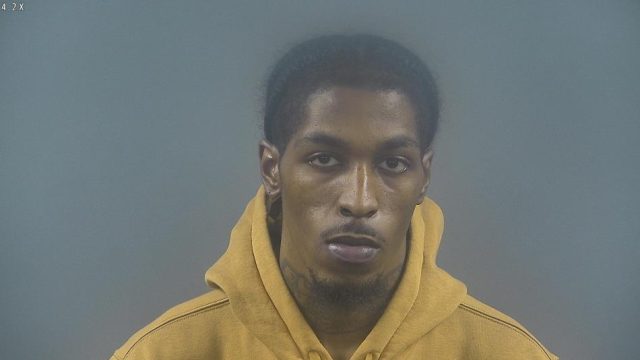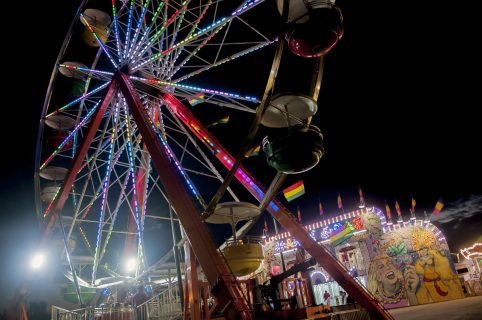Marc Owens
Published 12:00 am Wednesday, October 17, 2007

- Foster & Lloyd at the Grand Old Opry
When the history of music in and from Bowling Green is taken into consideration, alongside the more widely famous figures like Sam Bush, Bill Lloyd, or Tommy Johnson.
Owens talked with the Amplifier at his present High Street Studio; it continues to record many projects, mainly now for Hillvue Heights Church and for friends. The last two years have represented a “pretty serious music hobby” for him, keeping his studio busy. From a couch in the studio, Owens told stories in rapid-fire succession of his many experiences as a musician, soundman, and studio owner.
Trending
Seeing Ringo Starr on television did it for Marc, and he had his first drum set at age 10, a Slingerland kit. He grew up a few blocks down from Bill Lloyd, a relationship that remains tight to this day. Owens’ first band was with guitarist Bobby Baldwin; it went through several incarnations, one version of which had Tommy Hendricks in it. Even early on, Owens worked in sound; his first live sound gig was at the Episcopal church where David Surface’s father was minister. Just out of high school, Owens worked with Slick Rock as a lighting/pyrotechnics/drum tech person; in the band’s last days, Owens assumed sound duties as well.
Wynlych Penn was next for Owens, a band with John Waller, Billy Smith and Ed Dansereau with Jeff Watson as sound man and fifth member. Owens quit percussion at Western Kentucky University to join Wynlych Penn. The band was signed with Triangle Talent in Louisville and played around the region. It was Marc’s first experience recording in a “real” studio, and the experience with Wynlych Penn “really tightened me up” as a drummer and exposed him to a lot of different rhythms.
Owens then moved to Nebraska and got married. He joined a hot area band Small Wonder that played Lincoln and Omaha, and he was sending tapes to Bill Lloyd that “blew him away,” said Owens. After nine months, Owens’s marriage went bust, and he moved into a house with the band members, which Marc described as “a house of arts” and a positive artistic place for him.
Owens returned to Bowling Green in 1980 when his father was dying of cancer. Ty Barc had morphed into Hi Fi by then and was happening in the area. Owens said he “pretty much lived” at Morningstar Studio interning and getting studio and engineering experience at the very popular studio. Also, Owens played in Sgt. Arms with Bill Lloyd, Ernest Raymer and David Surface with Jeff Watson as sound engineer. Sgt. Arms did their best four songs at Morningstar, according to Owens.
The next year, Owens started High Street Studio with Billy Smith of Wynlych Penn. High Street had the next generation of 8-track recording equipment from Morningstar’s. Unfortunately for Sgt. Arms, who had been the hot band in Bowling Green for a couple of years, Surface decided to make the move to New York about the time High Street opened.
High Street Studio saw a lot of Bowling Green’s best known musicians and groups at the time. The first Government Cheese single “Things Are More Like They Are Now Than They’ve Ever Been Before” was cut there. Yo Mama, the four-woman group that included Jonell Mosser and Cathey Stamps as well as Ann Myers, also recorded at High Street. Byron House lived just down the street from the studio and was there a lot; for those who may remember his sequencer-aided live performances of “19” with the Ken Smith Band, the new-at-the-time sequencer portions were done at High Street.
Trending
Following Sgt. Arms’ demise, Owens played with a who’s who of local musicians. He played with Ernie Raymer and Andy Stahl (before his acting career) at Eagles, Golden Branding Iron, and the VFW. He had a gig at the Literary Club with Anthony Kenney, Ed Dansereau, Beverly Smith, and Billy Smith. Owens also ran sound a lot at Picasso’s.
His friend and former bandmate Bill Lloyd had moved to Nashville and hooked up with fellow songwriter Radney Foster. Owens played drums on the Foster and Lloyd demos as well as on Lloyd’s rock demos.
When Foster and Lloyd broke big, it took Owens and a few Bowling Green natives along for the ride. “Nashville loved us – everybody loved Foster and Lloyd,” said Owens. Their first three road dates were in New York with Roy Orbison, and they did Summer Lights in Nashville, Austin City Limits, and TNN’s Nashville Now. Owens recalled how the band’s steel guitarist Bruce Boughton was being a “grandfather” teaching “this green band” how to act on tour. That band included Owens (drums), Kyle Frederick (guitar), Byron House (bass), Boughton, Mike McAdam (guitar) who played with Steve Earle, and David Dorris (road manager/sound). Owens, Frederick, House, Dorris, and of course Lloyd all had Bowling Green connections. By the next year, Foster and Lloyd were opening for Hank Williams Jr. and Restless Heart, along with shows with then-unknown guitarist/vocalist Vince Gill opening. It was “big steaks, great year,” according to Owens.
After two years on the road, Owens decided to leave the band and returned to Bowling Green and High Street Studio. He ran sound for the group Picture This and for the Kentucky Headhunters when they hit. In 1989 during the Picture This period, Marc met Melanie. They got married, and Marc closed High Street Studio – but not before recording the final Government Cheese album, doing the last takes in the Owens’ house out of town.
Owens started playing with Tommy Johnson and Tommy Hendricks during the next couple of years, with Chris Carmichael sitting in with his bandmates from Dixie Line. After leaving, Owens ran sound for Foster and Lloyd as a fill in in 1990 for two weeks and was spotted by Melvin Markham, who road manager for them at the time. Later in 1992 Markham hooked Owens up with Dennis Robbins, who had penned the Garth Brooks hit “Two Of a Kind” and was going on the road as a performer. Owens ran sound for Robbins’ band, including a night that was “the pinnacle of my mixing career” opening for Billy Ray Cyrus at Universal Amphitheater near Los Angeles. After scores of minor venues cleaning beer off sound cables, it was “22 minutes of an acoustically perfect environment with the LA elite” in a packed amphitheater, Owens recalled; the next night was “back in nowheresville, Texas cleaning cables.”
1993 saw Owens as sound man and production manager for a new country artist named Clay Walker. Once again, Owens was involved on a tour with a major artist, and again he wasn’t the only Bowling Green connection – Kyle Frederick was Walker’s road manager. It was a “big tour, big fun,” said Owens, opening for Alan Jackson and John Anderson. Well, there was a miscue in Dallas – somehow someone didn’t count heads, and the buses left town for Beaumont without Marc. He chased the tour on a Gray Line bus, getting to the show in Beaumont and to his sound board with eight seconds to spare.
High Street Studio had been re-established on a smaller scale in 1992 and gotten a new Mackie board just about the time Owens went on the road with Walker. After leaving Walker’s tour, Owens resumed the running of High Street. The studio moved again in 1995. Not long after, former bandmate Tommy Johnson recorded his Pockets album at High Street. Owens recorded friends and such in his studio, then cut a record for Hillvue Heights Church which sold 1,000 units. An opportunity was recognized, and Hillvue helped equip High Street with more recording gear, and both the church and many of its members (such as Chris Gray, previously featured in the Amplifier) recorded at High Street. Hillvue Heights is now on its eighth CD with the release of Far – Vue VIII.
Owens, who is a member of Hillvue Heights, is very active in charity work, especially the Son Rhea Foundation. He also is active in praise and worship and very satisfied with that activity; he referred to praise and worship as “the most fulfilling experience I will ever know behind a drum kit.”
High Street Studio has enabled Owens to work solely in music. The studio and related activities enabled Owens to leave his day job two years ago, and he says philosophically “Now I never go to work.” He does personal recording projects for his friends n- he still works with Lloyd on demos, and Jack Montgomery’s latest release was recorded at High Street — and projects for Hillvue Heights. Owens has started making CDs as well through High Street. That “pretty serious music hobby” continues to be good to Owens.






